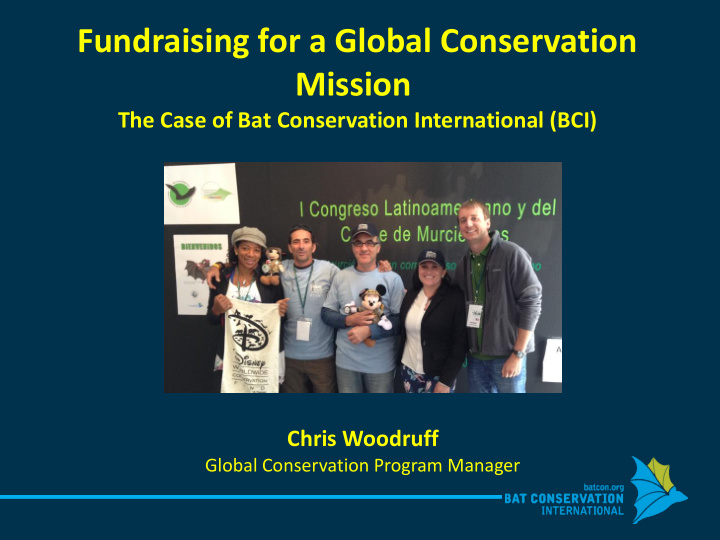



Fundraising for a Global Conservation Mission The Case of Bat Conservation International (BCI) Chris Woodruff Global Conservation Program Manager
About BCI BCI’s First Year in 1982 • 1 employee, 1 letter to 100 supporters, 1 donation of $10,000, 1 international initiative, A LOT of work in the US generating publicity and awareness about bats BCI Today • 25 full-time employees in 4 departments and 2 offices • Philanthropy, Conservation Programs, Operations, and Communications • Projects in 20 countries on 5 continents • ~ 9,000 members who pay annual dues • > 30 institutional funders through grants and contracts • Annual Budget of ~$4.5 million • Mission Statement: Conserving the world's bats and their ecosystems to ensure a healthy planet
BCI’s Success Over 33 Years • Commit to solving an issue/problem/need • Bats are rarely prioritized by anyone. BCI’s niche is trying to fill this void. • Make personal and institutional connections through outreach and communications • “More than any other medium, photography showing the true nature of bats helped people begin to appreciate and understand them. So I of course took more pictures, gave more lectures, and published more articles .” -- Dr. Merlin Tuttle, BATS, Spring 1992 • Be strategic and seek to find “win - win” solutions • Connect with the priorities of others (at the local, national, or global levels) • Build strong partnerships with other experts and organizations • Fundraising never stops, and it is everyone’s job • Everyone at BCI is a conservationist and a fundraiser • Organizational growth and survival depend on “ unrestricted ” revenues
Fundraising for a Global Mission • A global mission is ambitious • >1,300 bat species; 78 EN/CR (IUCN) • Be prepared to justify the mission and explain why? • Within the mission, prioritize • Think beyond “projects” to programs/initiatives • Prevent Extinction of EN/CR species • Protect mega-populations • Preserve areas of high species diversity • Identify marketable components • Pieces of the mission that are feasible, high urgency, high impact, sellable to donors • Solicit financial support broadly • Think BIG and small when planning fundraising
Who and Where are the Donors? • Bats come in all shapes and sizes and are found all over the world … just like donors • Individuals • Foundations • Bequests • Corporations • Governments & Multi-Nationals
What Methods are Effective for BCI? Membership (focused on individuals) • BCI’s Membership Team processes new and renewal memberships • These are small annual donations in return for a sense of being part of the organization and receiving “member benefits” • Student Membership = $30 / year; Benefactor Membership = $1,000 / year • ~ 9,000 BCI members currently
What Methods are Effective for BCI? Major Gifts (focused on individuals and bequests) • BCI’s Major Gifts Team carefully cultivates potential and existing donors • Individuals with high giving potential (greater than $1,000 per year) • Planned giving / Bequests • Major donors may receive special benefits or opportunities
What Methods are Effective for BCI? Institutional Giving (focused on foundations, corporations, and governments/multi-nationals) • BCI’s Institutional Giving Team writes and submits grant/contract proposals • Constantly searching for new opportunities and reporting to existing donors • Must find ways to connect BCI’s mission with institutional giving priorities • We think beyond bats to forests, water, sustainable development, Indigenous cultures, etc. • >30 institutions currently giving to BCI through grants and contracts
How Can BCI’s Experience Help You? Successful fundraising is about being prepared for opportunities • Have a clear mission/vision for impact and set priorities • You need supporters, so share your stories, photos, field experiences, etc. with broad audiences (newsletters, social media, blogs, websites, professional meetings, schools) to spark interest and build awareness about your mission • Frame your projects as pieces of bigger programs/initiatives, and describe their impact – not simply a list of activities • And begin filling your fundraising toolbox now!
What Should be in Your Toolbox? • Write and maintain a strong Curriculum Vitae • Collect letters of recommendation and success stories as you complete projects from well-respected individuals, businesses, agencies, etc. • Compile lists of potential donors and research their history of giving • Know how to calculate the value of your time/salary • Keep copies of old grant proposals and budgets for future use • Practice telling friends and family about your goals and passion for conservation, and prepare a 30- second “sales pitch” so that you are ready when you meet a donor at a conference or on an airplane • Find local supporters and partners to expand your capacity for impact • Stay affiliated with a trusted NGO/institution capable of receiving funds from the donors that will not give to individuals
Thank you to Manuel Rodríguez for the invitation to speak at this Seminario Semanal CATIE I look forward to hearing your questions and participating in further discussion.
Recommend
More recommend